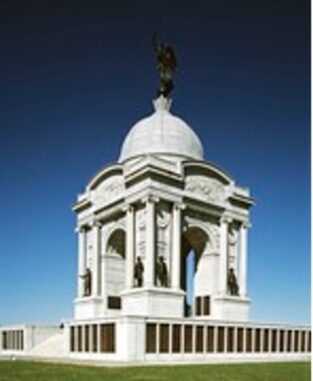Philanthropy
One Hundred Sixty Years of Patriotic Philanthropy at Gettysburg
Supporting knowledge and appreciation of American history, and democracy.
 Gettysburg Battlefield. License: Wikimedia Commons.
Gettysburg Battlefield. License: Wikimedia Commons.

This weekend marks the 160th anniversary of the Battle of Gettysburg, the great Union victory over the principal Confederate army in the eastern theatre that is widely cited as one of the crucial turning points of the American Civil War. Historians may argue, but no other battle did more to secure the final Union victory—and thus the preservation of the United States—than Gettysburg.
Today, the battlefield is exceptionally well-preserved as Gettysburg National Military Park, managed by the federal National Park Service and freely accessible to all visitors. Key to what today represents more than nine square miles of our most-precious national inheritance, almost from the moment the armies marched off the field in the summer of 1863, has been a dedicated base of citizens who recognized both the battle’s great historical significance and the importance of preserving the physical land upon which it was fought. Such efforts are a fine illustration of America’s tradition of “patriotic philanthropy.”
“To Secure and Perpetuate the Battlegrounds”
Guests who tour the park’s visitor center might notice a display explaining that the Gettysburg battlefield exists as it does today in part due to the vision of a local attorney named David McConaughy. Shortly after the battle ended, he began using his own funds to purchase tracts of land on Cemetery Hill, Culp’s Hill, and Little Round Top—three pieces of high ground that were crucial to the Union lines during the fighting. He publicly solicited the help of other “patriotic citizens of Pennsylvania” to further this work, and the Gettysburg Battlefield Memorial Association (GBMA) was soon formed “to secure and perpetuate the Battle-grounds of Gettysburg, with their natural and artificial defences, preserved in their actual form and condition at the time of the battles.” Membership shares in the GBMA were offered for $10 each, and in April 1864, it was chartered in Pennsylvania as a tax-exempt corporation.

Pennsylvania Memorial, Gettysburg National Military Park. License: Library of Congress.
The GBMA thus represented the first organized effort to preserve a Civil War battlefield, though it struggled financially in its early years. Harlan D. Unrau’s detailed 1991 administrative history of the battlefield noted that “despite the enthusiasm of the board of directors little real progress resulted from the efforts of the GBMA during the 1870s.” This changed after about 1880, when the Pennsylvania department of the Grand Army of the Republic (a Union veterans’ association) purchased a majority stake in the GBMA, assuming control of the board and shoring up its finances.
In 1881, the GBMA owned almost 150 acres of the battlefield. By 1885, this had grown to about 250 acres, plus an additional 40 acres that were privately held, but had been “dedicated by its owner” to the GBMA’s use and care. This land included not only McConaughy’s original purchases—for which he had been reimbursed—but also new acquisitions like the desperately fought-over Wheatfield and the portion of Little Round Top famously defended by the 20th Maine. The GBMA’s board authorized the purchase of Union Gen. George Meade’s headquarters in 1887, and part of the Peach Orchard (which saw vicious fighting on the battle’s second day) in 1890.
During this time, the GBMA constructed and improved many miles of roads to facilitate visitor access, supervised the placement of hundreds of monuments and memorials, and hosted reunions for veterans. John B. Bachelder, who had been working as an historian with the GBMA since at least 1869 and later was made the group’s Superintendent of Tablets and Legends, published a guidebook for battlefield tourists in 1873. According to Unrau, “it was Bachelder’s historical research efforts over the years since the battle on which the land acquisition, preservation, marking, and commemoration efforts had been based.” Today, a display in the Gettysburg visitor center notes that “Bachelder devoted his life to understanding the battle, and visitors today still benefit from his work.”
Though it had not been entirely without its critics, the GBMA’s work was nationally recognized, and by 1890, the battlefield’s 150,000 annual visitors certainly owed much of their experience to the association’s efforts. Still, there was a growing sentiment that the land belonged in federal hands. An 1888 article in The New York Times observed that the GBMA only owned a small fraction of the total surveyed battlefield, and the paper related how “galling” it was for a returning veteran to be told that he was “trespassing upon property for the preservation of which he shed his blood and risked his life.” At the same time, the GBMA had come to realize that it would likely never have sufficient funds to purchase the entire battlefield.
An 1885 pamphlet explained that the group had only two sources of funding: the $10 membership fees paid by the general public, and appropriations from northern states that wished to honor the contributions of their soldiers. This latter source was especially important. An accounting published after the GBMA wound down in 1895 recorded that it had received a total of $106,575.59 since 1864, of which $96,490 had been appropriated by state governments and $9,875.59 raised from memberships. The association claimed that all money it received “was expended in the purchase, restoration, improvement, and maintenance of the grounds.” Some salaries and related expenses were paid, but GBMA officers served in a volunteer capacity.
A Congressional bill authorizing the creation of Gettysburg National Military Park was signed into law in February 1895 by President Grover Cleveland. The GBMA subsequently voted to wind down its operations and transferred 522 acres of battlefield land to the War Department in 1896, in return for just under $2,000 to satisfy its outstanding debts. Today, the 6,000+ acre park is the direct descendant of McConaughy’s original 1863 land purchases. As to the GBMA’s legacy, historian Henry Sweetser Burrage wrote in 1906 that “it was a noble work that had been performed, and all those who had a part in it during those thirty-one years of its existence are entitled to lasting remembrance.”
Patriotic Philanthropy
Nonprofits and philanthropy still play a key role in preserving and memorializing the Gettysburg battlefield. The §501(c)(3) Gettysburg Foundation is a crucial partner with the National Park Service, helping acquire, preserve, and present everything associated with the battle. It also owns and operates the Gettysburg National Military Park Museum and Visitor Center, which opened in 2008 and is now the primary starting point for battlefield tourists.
The national American Battlefield Trust has preserved more than 1,200 acres of the battlefield—including Robert E. Lee’s headquarters, which it plans to eventually donate to the National Park Service. The Trust is currently fundraising to acquire and restore a small parcel of land immediately adjacent to the field upon which Pickett’s Charge took place. Nationwide, it says it has protected more than 56,000 acres of battlefield land. There is also the local Gettysburg Battlefield Preservation Association, which is the oldest extant such charity in the country, having been founded in 1959.
It has been a consistent theme throughout American history that private citizens will freely and enthusiastically contribute their time, money, and other resources to great causes that matter to them, even when they are of decidedly governmental concern. Indeed, the private charitable sector is very often better-positioned to take the initiative on such things. Historic preservation in particular offers donors the advantage of being able to point directly to the positive outcome that their gift helped bring about. This is not always such a simple thing in philanthropy.
Carlyle Group co-founder and major philanthropist David M. Rubenstein coined the term “patriotic philanthropy” to describe giving meant to help restore and preserve those tangible reminders of “the history and heritage of our country,” such as documents, buildings, monuments, and more. To Rubenstein, knowledge and appreciation of American history are key to the continued functioning of democracy today. Few could return from a visit to Gettysburg—itself the product of so much patriotic philanthropy—without a renewed appreciation of that democracy.
This article originally appeared in the Giving Review on June 29, 2023.


